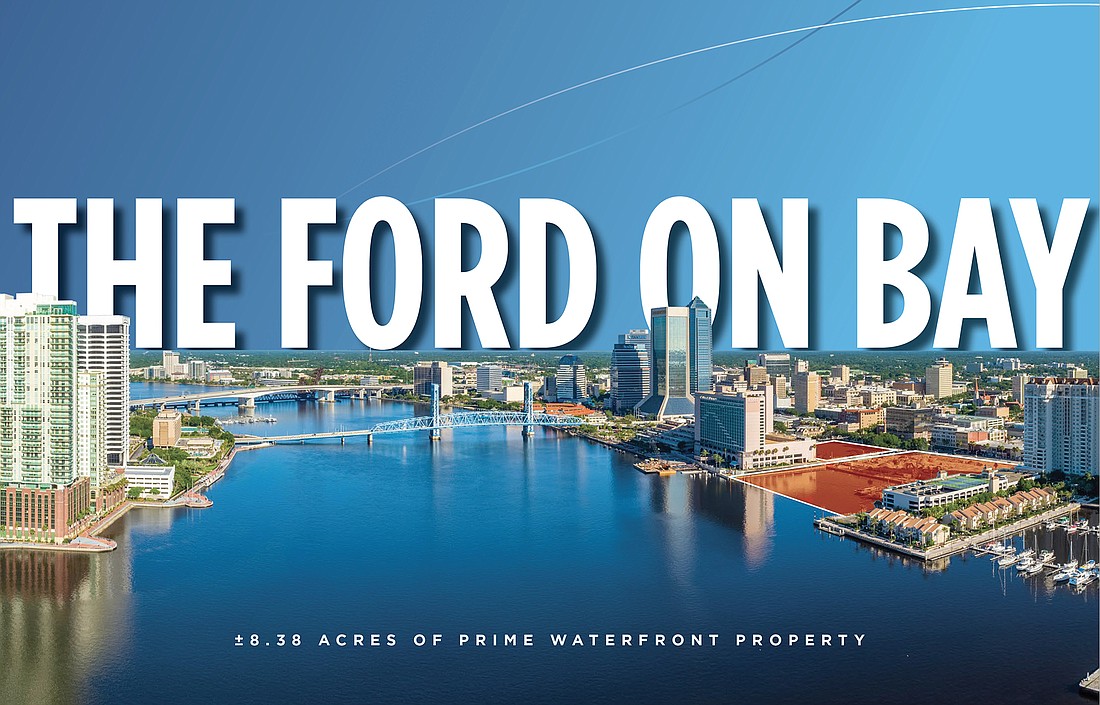
About 20 firms attended a preproposal meeting Tuesday for redevelopment of the former Duval County Courthouse and City Hall site, now called The Ford on Bay.
City officials and representatives from CBRE Jacksonville, the Downtown Investment Authority’s contracted real estate firm for the project, gave developers an overview of the 8.38-acre green space at 220 and 330 E. Bay St. and adjacent submerged land in the St. Johns River.
Area construction management firms including Perry McCall Construction LLC, Studio9 Architecture LLC and The Haskell Company attended the nonmandatory meeting.
The Ford on Bay also brought in early interest from firms outside Jacksonville.
New York-based Spandrel Development Partners LLC and Nashville, Tennessee-based developer Southern Land Co., among others, attended Tuesday’s meeting by conference call,
Spandrel performs both new construction and adaptive reuse projects, and its portfolio includes a 12-story, $450 million warehouse-to-condominium conversion called One Brooklyn Bridge Park in New York.
Southern Land Co. developed multifamily residential high-rise and mid-rise projects throughout the U.S.
Downtown Investment Authority CEO Lori Boyer said more than 100 developers and firms contacted CBRE during the prebid marketing for the property.
The DIA released a notice of disposition Oct. 21, requesting bids on the property.
Developers must submit proposals by Jan. 22 and DIA expects to award the project Feb. 20.
Taxes and other disqualifiers
DIA leaders want a larger scope for The Ford on Bay and issued several disqualifiers.
According to Cliff Taylor and Joe Ayers, CBRE’s co-leads for North Florida multifamily investment sales, firms with an active judgment lien of more than $10 million will not be considered for the project.
Bids from companies with unpaid taxes in excess of $1 million also will be disqualified.
The financial benchmarks come six months after another proposed city-backed redevelopment deal on Bay Street — the Berkman II — fell through as its developer struggled with back taxes.
Property owner 500 East Bay LLC failed to pay $58,600 in 2018 property taxes on time, according to Duval County Tax Collector records.
Parent company Barrington Development sought $36 million in city-backed financial incentives to proceed with the project it anticipated would require $122 million in private capital to complete.
The Florida Times-Union reported in April that Greg Stuart and companies connected to him or his wife, Lori Stuart — the sole trustee of primary Berkman II investor The Stuart Family Trust — were facing $11 million in financial judgments. The Times-Union reported Lori Stuart had ties to a struggling condominium project in New Orleans that owes more than $200,000 in delinquent property taxes and $79,000 in unpaid debts to contractors.
Taylor said Monday developers interested in building on all three Ford on Bay parcels are required to have experience with a single $120 million capital project of at least 650,000 square feet.
Developers bidding on one of the two land parcels must have a $50 million, 300,000-square-foot project in their portfolio. Those bidding on both land parcels need experience with a 600,000-square-foot, $100 million development. Bids to develop one land parcel and the water parcel should have a completed a 300,000-square-foot, $60 million project.
Scoring the proposals
City scorers will weigh an applicant’s experience and qualifications, economic benefit, project development and design, financial solvency and cash flow and its final oral presentation.
If a developer submits an alternate proposal for a different parcel combination, it will be scored separately from the firm’s primary bid.
The CBRE representatives said the scoring is intentionally weighted toward the quality of design. Although there’s not a requirement for a bid to include residential, Ayers said any project that increases Downtown’s housing density likely will be viewed more favorably.
“One of the overarching visions is to increase that residential density. These are waterfront sites, these are skyline sites. This is an opportunity to really define the skyline of Downtown. We all see the shots of Downtown when we’re watching football games or whatever the case is — very visible sites,” Taylor said.
Boyer said the initial three-person scoring committee comprising a DIA board member, a DIA staffer and a representative from Mayor Lenny Curry’s administration will make an initial recommendation.
The bids then will be referred to the DIA’s four-member Retail Enhancement and Property Disposition Committee. Boyer expects those committee members to be appointed at the DIA board’s Nov. 13 meeting.
'Cone of silence' period
Their recommendation will then go to the full board for final consideration.
City Procurement Division Analyst David Klages said when bids are opened Jan. 22, only the names of the companies and not the full proposals will be disclosed to the public.
The DIA is calling the one-month gap between the bid opening and the Feb. 10 deadline for the initial evaluation committee to submit their scores a “cone of silence” period.
At the DIA’s Oct. 16 meeting, City Council member Michael Boylan, who is the Council liaison to DIA, called the process “eerily familiar,” referring to the ongoing closed negotiations in the possible sale of JEA.
Boyer said the JEA debate put a “negative connotation” on the cone of silence period and, at first, “didn’t want to have it at all.”
“We addressed it upfront. We were sensitive to the JEA debate and we didn’t want to withhold information from Council members and from other people because it will ultimately go through the Council,” Boyer said. “But we were also sensitive to protecting the integrity of the processes during the bidding.”
Boyer said once bids have been opened, the DIA and the City Procurement Division will notify Council that the proposals are available for view at the procurement office.
“The concept is the scorers need to score without outside influence or lobbying from any bidder,” Boyer said. “Once they’ve done their scoring sheet and they’ve turned it into procurement then it’s available to everybody before it goes to our review committee.”